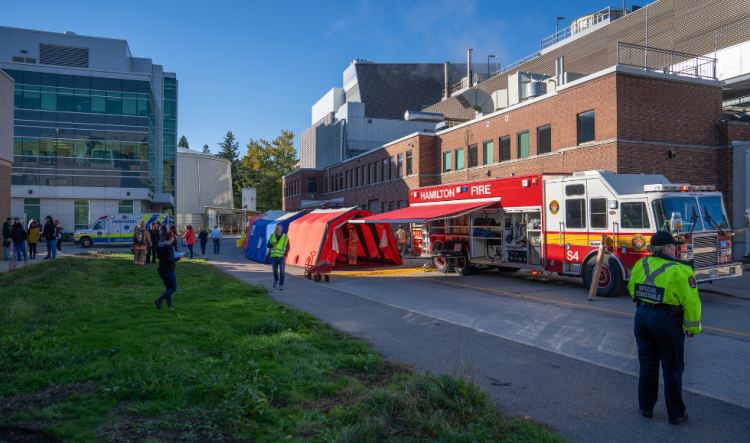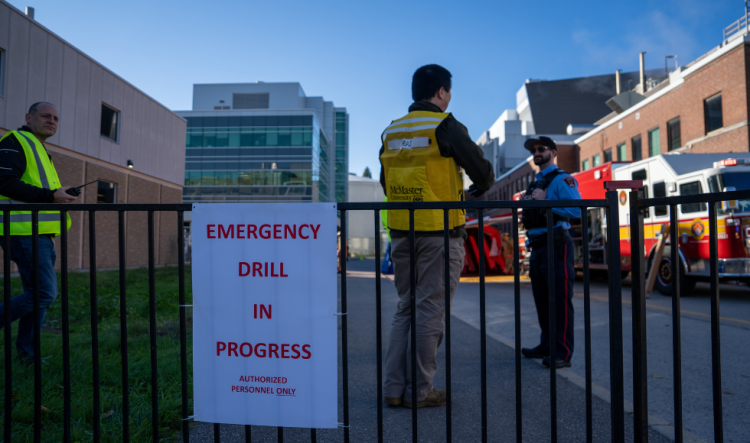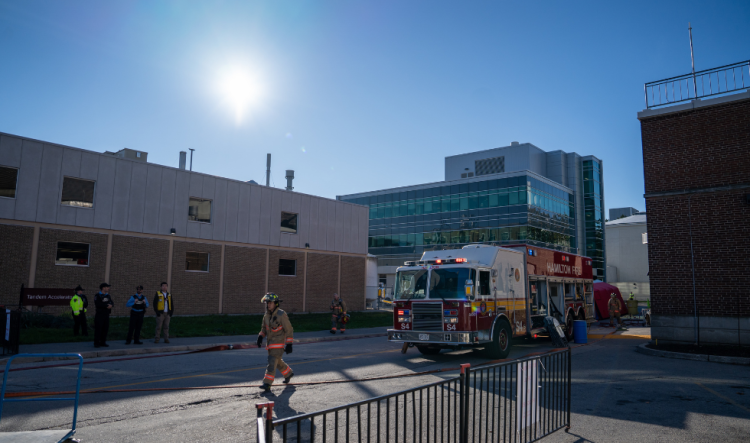
The area around the McMaster Nuclear Reactor and Nuclear Research Building was fenced off Oct. 9 to facilitate a routine emergency response drill in collaboration with local first responders.
University leaders, staff and city emergency services gathered at the McMaster Nuclear Reactor (MNR) earlier this month for a routine radiological incident response exercise.
The exercise involved an accident scenario in MNR Canada's largest nuclear research reactor and world-leading supplier of medical isotopes.
Safety exercises like this one occur every few years and are designed to test McMaster and the city's response to the very unlikely event of an emergency scenario.

Set up for the drill began at 7 a.m., with fencing put up around the Nuclear Research Building and the reactor.
Personnel from McMaster's Health Physics, Nuclear Operations & Facilities, Crisis Management team and Security Services participated in the drill alongside the Hamilton Fire Department, Hamilton Paramedic Service and Hamilton Police Service.
The exercise showcased the level of collaboration, coordination and preparedness it takes to safely and effectively run a world-class nuclear research facility like MNR, says Josip Zic, director of Health Physics.
"It's highly unlikely that a radiological accident will occur inside the reactor," says Zic.
"Still, it's extremely important that we test our response to such a scenario. This exercise was a valuable opportunity to review and strengthen our capabilities, responsibilities and objectives in the event of an emergency. Most importantly, it brought the University and the city together as a team to advance the safety of all those who visit, work and study in and around our nuclear facilities."
Over 150 McMaster staff and emergency responders participated in the exercise.
Several Health Physics staff were tasked with setting up and leading stations to monitor radiation levels in and around the reactor as would be required if there was an actual radiological emergency.

Hamilton firefighters participated in the drill. They consult with on-site MNR and Health Physics staff to understand the radiological conditions of the emergency and determine the best way to respond to the situation.
Emergency service personnel, including firefighters, police officers and paramedics, also share responsibility for monitoring the safety and well-being of those within the affected area.
Every few years, McMaster hosts training sessions with first responders to ensure that they have the knowledge and experience needed to respond to emergencies involving radioactive materials on and off campus.
Inside the Nuclear Research Building, leadership from McMaster and the City of Hamilton worked together to implement McMaster's radiological incident response plan.
The response mission is built around a central goal: protecting the safety of people, the environment and property within the area affected by the incident. To this end, the emergency response team works to stabilize and contain the incident to prevent it from escalating.
Each team member has an important role to play including liaising with first responders at the site of the incident, executing an effective containment solution and keeping the media and community members informed about the situation.
The exercise was evaluated by representatives of the Canadian Nuclear Safety Commission (CNSC Canada's nuclear materials regulator who were performing a regulatory inspection on Emergency Preparedness in parallel with the exercise.
The exercise was also observed by representatives from Emergency Management Ontario and the City of Hamilton Emergency Operations Centre. Feedback received from these organizations will be used to further improve McMaster's emergency response capabilities.
Emergency response exercises are part of McMaster University's licence responsibilities, as per the CNSC's guidelines.
The MNR emergency plan has never been implemented in response to an actual emergency in the reactor's 65-year history.
Earlier this year, the CNSC granted the McMaster Nuclear Reactor a 20-year operating licence renewal a testament to MNR's long and safe history of nuclear research and innovation.
Over 1200 faculty, staff and students work with radioactive materials across campus on a regular basis. Their work advances research on clean energy technologies, the development of next-generation materials and the production of medical isotopes used to diagnose and treat diseases like cancer.












